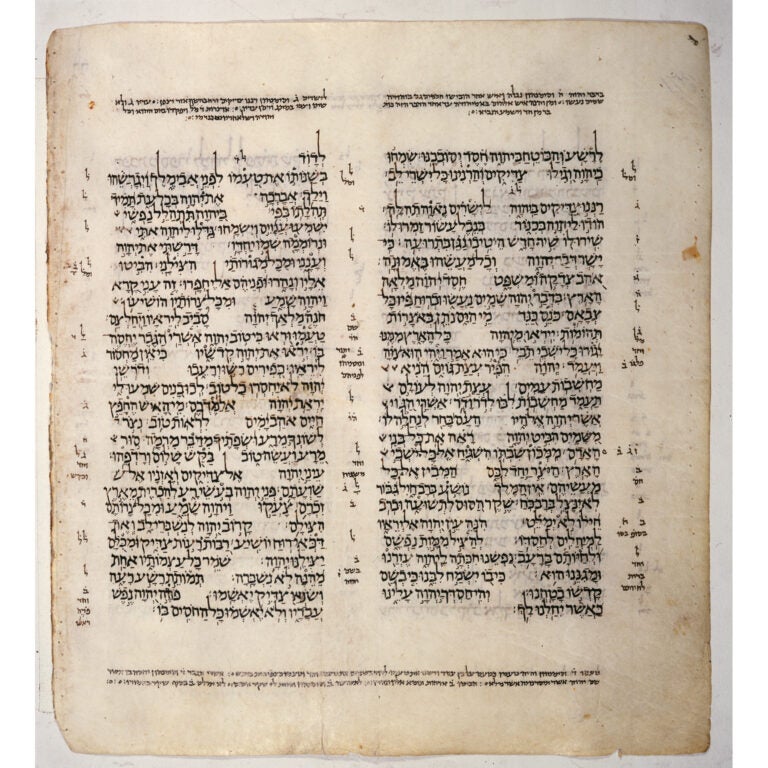Introduction
The Leningrad Codex, or Leningradensis, is the oldest complete Hebrew Bible still preserved. While there are older parts of Bibles or biblical books, still in existence, there is no older manuscript which contains the whole Hebrew Bible (or Old Testament in Hebrew). The Leningrad Codex is considered one of the best examples of the Masoretic text.
The manuscript was written around the year 1010 C. E. It was probably written in Cairo, and later sold to someone living in Damascus. Today it is in St. Petersburg, Russia, in the National Library of Russia, where it has been since the mid-1800’s. When the Ancient Biblical Manuscript Center and West Semitic Research photographed the Bible in 1990, the city was still called Leningrad. The name of the manuscript continues to be called the Leningrad Codex in order to avoid confusion.
The Leningrad Bible is called a “Codex” because it is in the form of a book (“codex” being an old word for “book”). The Bibles in the synagogues were in the form of scrolls, which meant that one never had an entire Bible together in one scroll. The codex would not have been used in the synagogue but would have been used as a study Bible by students and scholars.
Most modern printed editions of the Hebrew Bible use the Leningrad Codex,together with a few other incomplete Hebrew Bibles, as the basis for their translations. This is because it is the oldest complete manuscript copied with the Masoretic system developed by the Ben Asher family.
What do we mean when we talk about the Masoretic Text?
This manuscript belongs to a group of Hebrew texts called the Masoretic texts. The Hebrew alphabet itself, which developed from the Phoenician alphabet, has no true vowels, so the oldest Hebrew biblical fragments have only consonants, some of which are used as half-vowels, like our y, w, and h.
Sometime in the Middle Ages, a group of scholars called Masoretes became interested in developing a system for marking the vowels. They were concerned that the pronunciation of the words might be lost since Hebrew was no longer a spoken language. Besides vowels, they also wanted a way of marking punctuation, accents, and the musical notes used when the biblical text was chanted in the synagogue.
The most popular system of signs was developed by the Ben Asher family, and it is their system that is preserved in the Leningrad Codex. If you look carefully at a page you can see that the consonants, or letters, have little marks above and below them. Some of the marks are called “vowel points,” and some are called “accents.” The accents both act as punctuation and as musical notation.

The Masoretes were also interested in copying the biblical text very carefully so that it would be preserved from generation to generation. The way they tried to ensure this was the use of notes in the margins. In the margins beside the biblical verses, they put little letters as symbols. These symbols told the scribe copying the text information about unusual forms or words that should not be changed. For instance, they might put a circle over a word that occurred nowhere else in the Bible. In the margin, they would then put the letter “l” which told the scribe, “yes, this is a unique word, but it is not an error, so just copy it the way it is.” The notes at the top or bottom of a page would usually give more information about the symbols in the side margins.

What books of the Bible does the Leningrad Codex contain?
The Codex includes all of the books in the Jewish Bible or the Protestant Old Testament. The order of books in the Leningrad Bible is not quite the same as you will usually find in a modern Bible. First of all, the books are in the Jewish order, divided into three main parts: Instruction (Torah), Prophets (Nevi’im) and Writings (Ketuvim). In modern Jewish Bibles the order of the books is:
Torah: Genesis, Exodus, Leviticus, Numbers, and Deuteronomy
The Prophets: Joshua, Judges, Samuel (1&2), Kings (1&2)
Isaiah, Jeremiah, Ezekiel
The Twelve minor prophets (Hosea, Joel, Amos, Obadiah, Jonah, Micah,
Nahum, Habakkuk, Zephaniah, Haggai, Zechariah, Malachi).
The Writings: Psalms, Proverbs, Job, The Song of Songs, Ruth, Lamentations,
Ecclesiastes, Esther, Daniel, Ezra, Nehemiah, and Chronicles (1&2).

The Leningrad Codex contains all these books, plus extensive scholarly notes, and 16 illuminated (decorative) pages. However, the order is a little bit different than what you would find in a modern Jewish Bible.
Torah: Genesis, Exodus, Leviticus, Numbers, and Deuteronomy
The Prophets: Joshua, Judges, Samuel, Kings
Isaiah, Jeremiah, Ezekiel
The Twelve minor prophets (Hosea, Joel, Amos, Obadiah, Jonah, Micah,
Nahum, Habakkuk, Zephaniah, Haggai, Zechariah, Malachi).
The Writings: Chronicles, Psalms, Job, Proverbs, Ruth, The Song of Songs, Ecclesiastes, Lamentations, Esther, Daniel, Ezra-Nehemiah.
Notice that the books of Samuel, Kings, Chronicles, and Ezra-Nehemiah are all one book in this manuscript, which, of course, they were original. Notice, too, that the Twelve minor prophets make up one book. This is because at one time they were all copied together on one long scroll.
Photograph by Bruce and Kenneth Zuckerman, West Semitic Research, in collaboration with the Ancient Biblical Manuscript Center. Courtesy National Library of Russia (Saltykov-Shchedrin).

Biblical Manuscripts
- Leningrad Codex (General Information).
- Leningrad f.40b (Folio 40b – a page of biblical text).
- Leningrad Carpet Page (An illuminated page).
Article Categories
Non-Biblical Ancient Texts Relating to the Biblical World: Non-biblical inscriptions and documents from ancient times that improve our understanding of the world of the Bible.
Biblical Manuscripts: Images and commentary on ancient and medieval copies of the Bible.
Dead Sea Scrolls: Images and commentary on selected Dead Sea Scrolls manuscripts.
USC Archaeology Research Center: Images of artifacts from the teaching collection of the University of Southern California.